ESP MERCEDES-BENZ E-CLASS CABRIOLET 2010 User Guide
[x] Cancel search | Manufacturer: MERCEDES-BENZ, Model Year: 2010, Model line: E-CLASS CABRIOLET, Model: MERCEDES-BENZ E-CLASS CABRIOLET 2010Pages: 333, PDF Size: 7.64 MB
Page 23 of 333

Inform Mercedes-Benz as soon as poss
ible
abou tany change in address or vehicl eown-
ership. Correct use
Observe the following info rmation when using
your vehicle:
R the safety notes in this manual
R the "Technical data” section in this manual
R national road traffic regulations
R national road traffic licensing regulations G
Risk of injury
Various warning stickers are affixed to your
vehicle. Their purpose is to draw your atten-
tion, and the attention of others, to various
dangers. Therefore, do not remove any warn-
ing stickers unless the sticker clearly states
that you may do so.
If you remove the warning stickers, you or
others could be injured by failing to recognise
certain dangers. Implied warranty
! Follow the instructions in this manual
about the proper operation of your vehicle
as well as about possible vehicle damage.
Damage to your vehicle that arises from
culpable contraventions against these
instructions are not covered either by
Mercedes -Benz implied warranty or by the
New or Used-Vehicle Warrant yof
Daimler AG. Data stored in the vehicle
Fault data
Compone ntsc ritical for vehicl eoperation are
equipped with fault data memories as stand-
ard. There are also memories dedicated to
storing the technica lreactions of vehicle
component stodriving situations (e.g. the
trigge ring of an airbag ,ESP ®
intervention). This data is used exclusively to:
R assist in the rectification of faults and
defects
R help Mercedes-Benz optimise and develop
vehicle functions
The data cannot be used to trac ethe vehicle's
movements.
When your vehicle is serviced by Mercedes-
Ben z,this technical information can be read
out from the fault memory. Thi sisperformed
by authorised employees of the Mercedes-
Benz service network using special diagnos-
tic computers.
Af teraf ault has been rectified, the informa-
tion is deleted from the memory. Other mem-
ory data is constantly overwritten. Other devices tha
tstore data
Depe nding on the equipment level, your vehi-
cle may featur ecommunication sand/or
entertainment systems (e.g .navigation devi-
ces, telephone systems). Thes eallow you to
save and edit data required for the operation
of the respective device.
Fur ther information on operation (e.g. on
deletin gdata) can be found in the separate
operating instructions. 20
Introduction BA 207 ECE ÄJ 201
0/1a; 1; 2, en-GB
mkalafa Version: 3.0.2.11 2010-01-26T13:03:22+01:00-Seite 20
Page 28 of 333
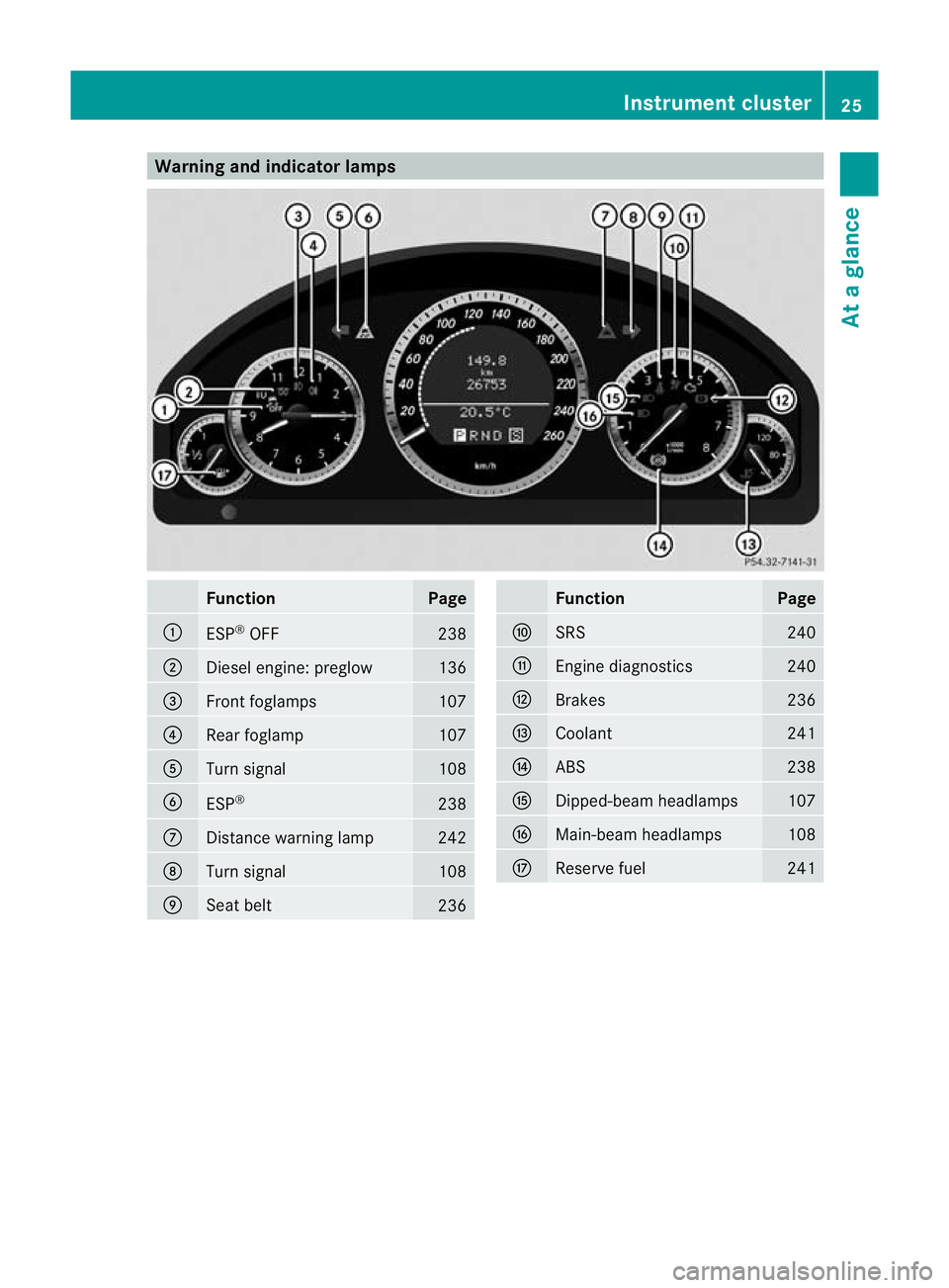
Warnin
gand indicator lamps Fun
ction Page
:
ESP
®
OFF 238
;
Diesel engine: preglow 136
=
Fron
tfoglamps 107
?
Rear foglamp 107
A
Turn signal 108
B
ESP
® 238
C
Distance warning lamp 242
D
Turn signal 108
E
Seat belt
236 Function Page
F
SRS 240
G
Engine diagnostics 240
H
Brakes 236
I
Coolant 241
J
ABS 238
K
Dipped-beam headlamps 107
L
Main-beam headlamps 108
M
Reserve fuel 241Instrument cluster
25Atag lance
BA 20 7ECE ÄJ 2010 /1a; 1; 2, en-GB
mkalafa Version: 3.0.2.11 2010-01-26T13:03:22+01:00 -Seite 25
Page 37 of 333
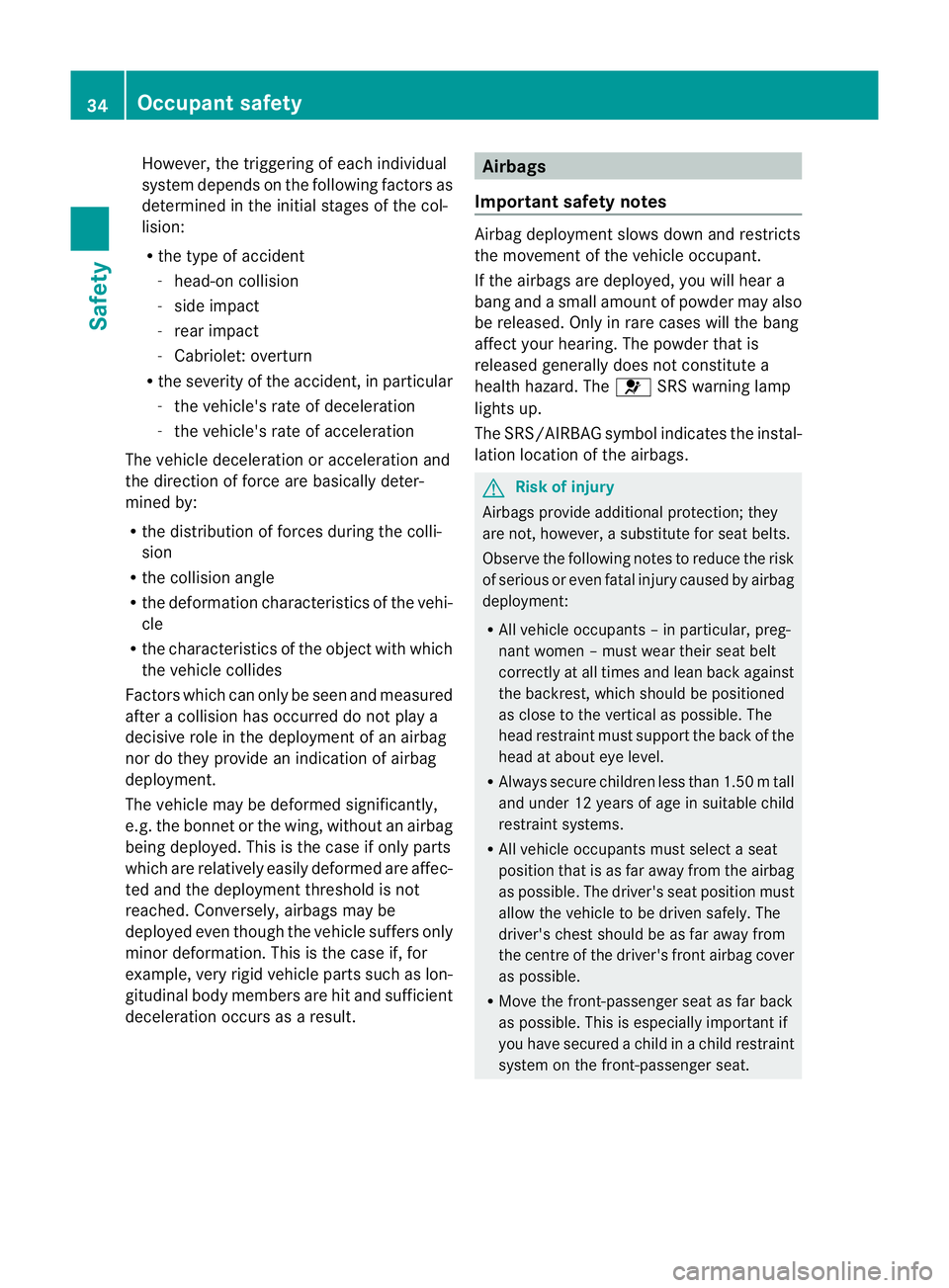
However, the trig
gering of each ind ividual
system depends on the following factors as
determined in the initial stages of the col-
lision:
R the type of accident
- head-on collision
- sid eimpact
- rea rimpact
- Cabriolet: overturn
R thes everity of the accident, in particular
- the vehicle's rat eofdeceleration
- the vehicle's rat eofacceleration
Th ev ehicle deceleration or acceleration and
the direction of force ar ebasicall ydeter-
min edby:
R the distri bution of force sduring the colli-
sion
R the collision angle
R the deform ation characteristics of the vehi-
cle
R the characteristics of the object with which
the vehicle collides
Factors which can only be see nand measured
after acollision has occ urreddon ot play a
decisive role in the deployment of an airbag
nor do they provid eanindicatio nofairbag
deployment.
The vehicle may be deformed significantly,
e.g. the bonnet or the wing, withou tanairbag
being deployed. This is the case if only parts
which are relatively easily deformed are affec-
ted and the deploymen tthreshol disnot
reached. Conversely ,airbags may be
deployed even though the vehicle suffer sonly
minor deformation. Thi sisthe case if, for
example, ver yrigid vehicle parts such as lon-
gitudinal body member sare hi tand sufficient
deceleratio noccurs as aresult. Airbags
Important safety notes Airbag deployment slows down and restricts
the movemen
tofthe vehicle occupant.
If the airbags ar edeployed, you will hear a
bang and asmall amount of powder may also
be released. Only in rare cases will th ebang
affect your hearing. The powde rthat is
released generally does not constitute a
healt hhazard. The 6SRS warning lamp
lights up.
The SRS/AIRBAG symbol indicates the instal-
lation location of the airbags. G
Risk of injury
Airbags provide additional protection; they
are not, however, asubstitute for seat belts.
Observe the following notes to reduce the risk
of serious or even fatal injury caused by airbag
deployment:
R All vehicle occupants –inparticular ,preg-
nant women –must wear their seat belt
correctly at all times and lean back against
the backrest, which should be posi tioned
as close to th evertical as possible. The
head restraint must support th eback of the
head at about eye level.
R Always secur echildren less than 1.50 mtall
and under 12 years of age in suitable child
restraint systems.
R All vehicle occupant smust select aseat
position that is as far away from the airbag
as possible. The driver' sseat position must
allow the vehicle to be driven safely .The
driver's chest should be as fa raway from
the centre of the driver' sfront airba gcover
as possible.
R Move the fr ont-passengers eat as far back
as possible. This is especially impor tantif
you have secured achild in achild rest raint
system on the front-passenger seat. 34
Occupant safetySafety
BA 207 ECE ÄJ 201
0/1a; 1; 2, en-GB
mkalafa Version: 3.0.2.11 2010-01-26T13:03:22+01:00-Seite 34
Page 38 of 333
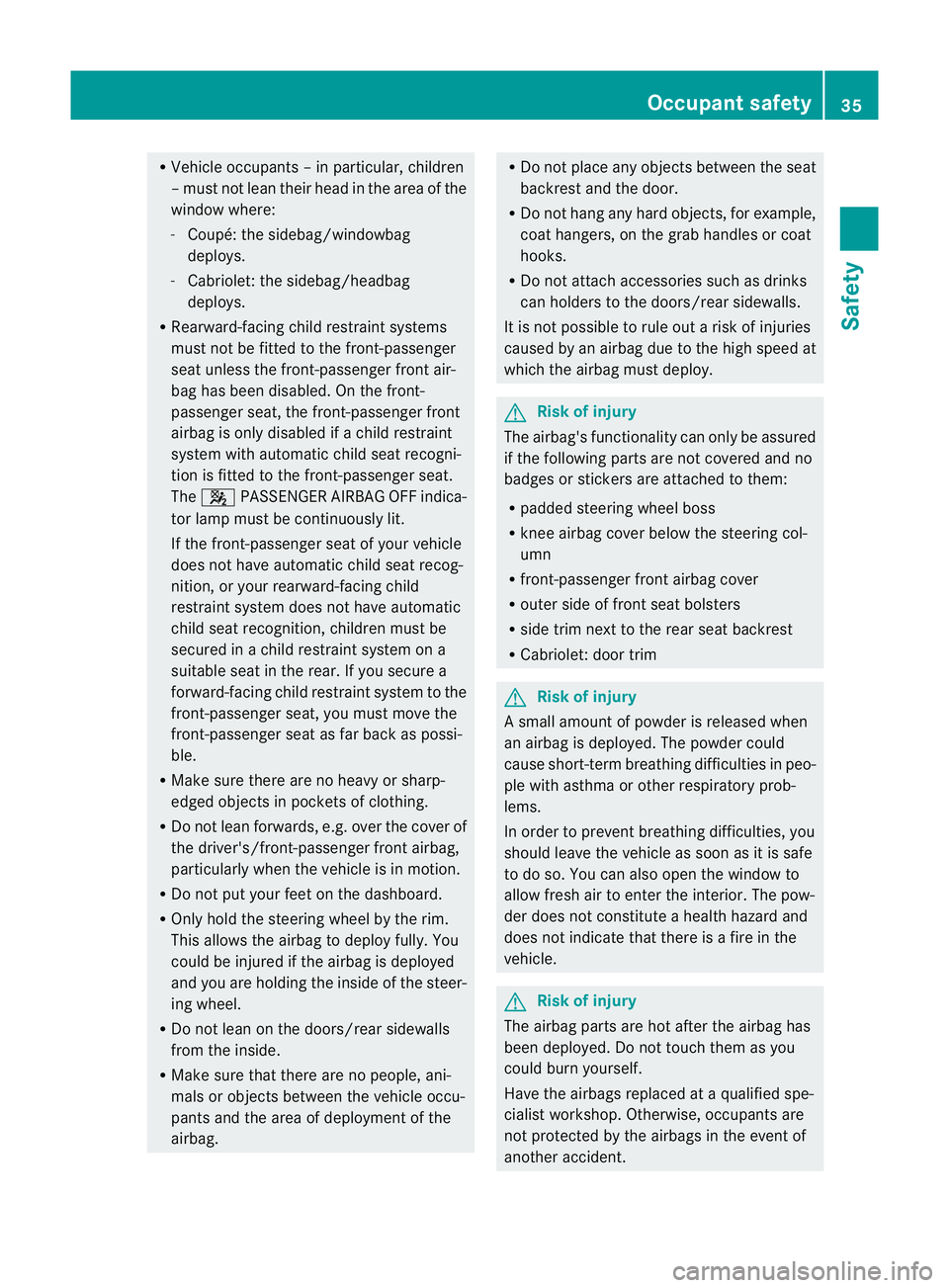
R
Vehicl eoccupant s–inparticular ,children
–m ust not lean their head in the area of the
window where:
- Coupé: the sidebag/windowbag
deploys.
- Cabriolet: the sidebag/headbag
deploys.
R Rearward-facin gchild rest raint systems
must not be fitted to the front-passenger
seat unless the front-passenger fron tair-
bag has been disabled. On the front-
passenger seat, the front-passenger front
airbag is onl ydisabled if achild restraint
system with automatic chil dseat recogni-
tion is fitted to the front-passenger seat.
The 4 PASSENGER AIRBA GOFF indica-
tor lamp must be continuou slyl it.
If the front-passenge rseat of your vehicle
does not have automati cchild seat recog-
nition, or your rearward-facin gchild
rest raint system does not have automatic
child seat recognition, children must be
secured in achild rest raint system on a
suitable seat in the rear. If you secure a
forward-facin gchild rest raint system to the
front-passenger seat, you must move the
front-passenger seat as far back as possi-
ble.
R Make sure there are no heavy or sharp-
edged objects in pockets of clothing.
R Do not lean forwards, e.g. over the cover of
the driver's/front-passenger fron tairbag,
particularly when the vehicle is in motion.
R Do not put your feet on the dashboard.
R Only hold the steerin gwheel by the rim.
This allow sthe airbag to deploy fully. You
coul dbei njured if the airbag is deployed
and you are holding the inside of the steer-
ing wheel.
R Do not lean on the doors/rear sidewalls
from the inside.
R Make sure that there are no people, ani-
mals or obje ctsb etween the vehicle occu-
pants and the area of deployment of the
airbag. R
Do not place any objects between the seat
back rest and the door.
R Do not hang any har dobjects, for example,
coat hangers, on the grab handles or coat
hooks.
R Do not atta chaccessories such as drinks
can holders to the doors/rear sidewalls.
It is not possible to rule out arisk of injuries
caused by an airbag due to the high speed at
which the airbag must deploy. G
Risk of injury
The airbag' sfunctionality can only be assured
if the following parts are not covered and no
badge sorstickers are attached to them:
R padded steerin gwheel boss
R knee airbag cover below the steerin gcol-
umn
R front-passenger fron tairbag cover
R outer side of fron tseat bolsters
R side tri mnexttot he rea rseat back rest
R Cabriolet :door trim G
Risk of inju
ry
As mall amo untofp owder is released when
an air bagisd eployed. The powder could
cause short-term breathing difficulties in peo-
ple with asthma or other respirator yprob-
lems.
In order to prevent bre athing difficulties ,you
should leave the vehicle as soon as it is safe
to do so. You can also open the window to
allow fresh air to enter the interior .The pow-
der does not constitute ahealth hazar dand
doe snot indicat ethat ther eisaf ire in the
vehicle. G
Risk of injury
The airbag parts are hot after the airbag has
been deployed. Do not touch them as you
could burn yourself.
Have the airbags replaced at aqualified spe-
cialist workshop .Otherwise, occupants are
not protected by the airbags in the event of
another accident. Occupant safety
35Safety
BA 207 ECE ÄJ 2010/1a; 1; 2, en-GB
mkalafa Version:3.0.2.11
2010-01-26T13:03:22+01:00
-Seite 35 Z
Page 43 of 333

Resetting trig
geredN ECK-PR Ohead
restraints
Mercedes-Ben zrecom mends that you have
NECK-PRO hea drestraint schecked at aquali-
fied specialist workshop, e.g. aMercedes-
Ben zService Cent re,followin garear-en dcol-
lision.
i Resetting the NECK -PRO head restraints
requires alot of strength. If you have diffi-
culty resettin gthe NECK -PRO head
restraints, have this work carried out at a
qualified specialist workshop, e.g. a
Mercedes-Benz Service Centre. Example: Coupé
X
Tilt the top of the NECK-PRO head restraint
cushio nforwards in the direction of
arrow :.
X Push the NECK -PRO head restraint cushion
down as far as it will go in the direction of
arrow ;.
X Firmly push the NECK-PRO head restraint
cushio nbackwards in the direction of
arrow =until it engages.
X Repeat this procedure for the second
NECK -PRO head restraint. Seat belts
Important safet ynotes Seat belts are the most effective means of
restrainin gthe movemen tofvehicle occu-
pant sint he even tofanaccide nt.T his reduce
sthe risk of vehicle occupants coming
int oc ontac twith parts of the vehicle interior. G
Risk of injury
As eat belt which is not worn cor rectly, or
which has not bee nengaged in the sea tbelt
buckle cor rectly, cannot perform its intended
prote ctive function .Under certain circum-
stances, this could cause severe or even fatal
injuries in the event of an accident.
Make sure that all occupants –inparticular,
pregnan twome n–w ear their seat belt cor-
rectly at all times.
R The seat belt must fit snugly on your body
and must no tbetwisted. Therefore, you
should avoid wearing bulky clothin g(e.g. a
winter coat) .The shoulder belt section
must be routed across the cen treofy our
shoulder –onnoaccount acros syour neck
or under your arm –and pulled tight against
your uppe rbody. The lap belt must always
pass across your lap as low down as possi-
ble, i.e. over your hip join ts–n ot across
your abdomen. If necessary ,push down the
belt strap slightly and then retighten it in
the roll-up direction.
R Do not route the belt strap across sharp
edge sorfragil eobjects, especially if these
are located on or in your clothing, e.g. spec-
tacles, pens, keys, etc. The seat belt strap
could be damaged and tear in an accident,
and you or other vehicl eoccupants could
be injured.
R Onl yone person should use each sea tbelt
at any one time. Children must never travel
sittin gont he lap of other occupan ts.It
would not be possible to restrain the child
in the event of asudden change in direc-
tion, braking or an accident .This could
result in sever eoreven fata linjuries to the
child and othe roccupants.
R Persons les sthan 1.50 mtall cannot wear
the seat belts correctly. For this reason,
secure persons less than 1.50 mtall in spe-
cially designed, suitable restraint systems. 40
Occupant safetySafety
BA 20
7ECE ÄJ 2010/1a; 1; 2, en-GB
mkalafa Version: 3.0.2.11 2010-01-26T13:03:22+01:00-Seite 40
Page 44 of 333

R
Children less than 1.50 mtall or under 12
years of age cannot wear the seat belts
properly. Therefore, they always should be
secured in asuitable child restraint system
on asuitable vehicle seat. You can find
more information under "Children in the
vehicle" in the "Safety" section of the Own-
er's Manual. Follow the manufac turer's
installatio ninstructions whe nfitting the
child restraint system.
R Do not secure any objects with aseat belt
if the seat belt is also being used by one of
the vehicle's occupants. G
Risk of injury
The seat belt does not offer the intended level
of protection unless the back rest is almost
ver tical. Under certain circumstances, this
coul dcause severe or even fatal injuries in the
event of an accident.
Befor estarting ajourney, mak esure that the
seat is properly adjusted and that the back-
rest is almost vertical. G
Risk of injury
Ad irtyo rdamaged seat belt or aseat belt that
has been subjected to aload in an accident
or which has been modified no longer offers
the intended level of protection. Un dercertain
cir cumstances, this could caus esever eor
even fatal injuries in the even tofanaccident.
For thi sreason, check regularly that the seat
belts are not damaged or dirty.
Alway shaved am aged sea tbelts or seat belts
that have been subjected to aload in an acci-
dent replaced at aqualified specialist work-
shop. Consult aqualified specialist workshop
which has the necessary specialist knowledge
and tools to carry out the work required.
Mercedes -Benz recommends that you use a
Mercedes-Benz Ser vice Centre for thi spur-
pose.
For safety reasons, Mercedes -Benz recom-
mends that you only use seat belts which have
been approved by Mercedes-Benz for your
vehicle. Fastening seat belts The seat-belt extender for the driver and front
passenger helps you fasten your seat belt.
Example: Coupé
Seat-belt extender
:is extended when the
respective door is closed and the key is
tur nedtop osition 1or 2in the ignition lock.
You can also activa teseat -belt extender :
by using the seat-belt extender button in the
centre console. X
Press the seat-belt extender button.
Seat -belt extender :extends. G
Risk of inju
ry
The seat-belt extender must be ret racted
whe nthe vehicle is in motion .Only then can
the sea tbelt fit properly on the body and per-
for mi ts protective function.
Seat-belt extender :is retracted again if:
R the belt tongue is engaged in the sea tbelt
buckle.
R the belt tongue is not engaged in the seat
belt buckle within 60 seconds. Occupant safety
41Safety
BA 207ECE ÄJ 2010/1a; 1; 2, en-GB
mkalafa Version: 3.0.2.11 2010-01-26T13:03:22+01:00-Seite 41 Z
Page 45 of 333
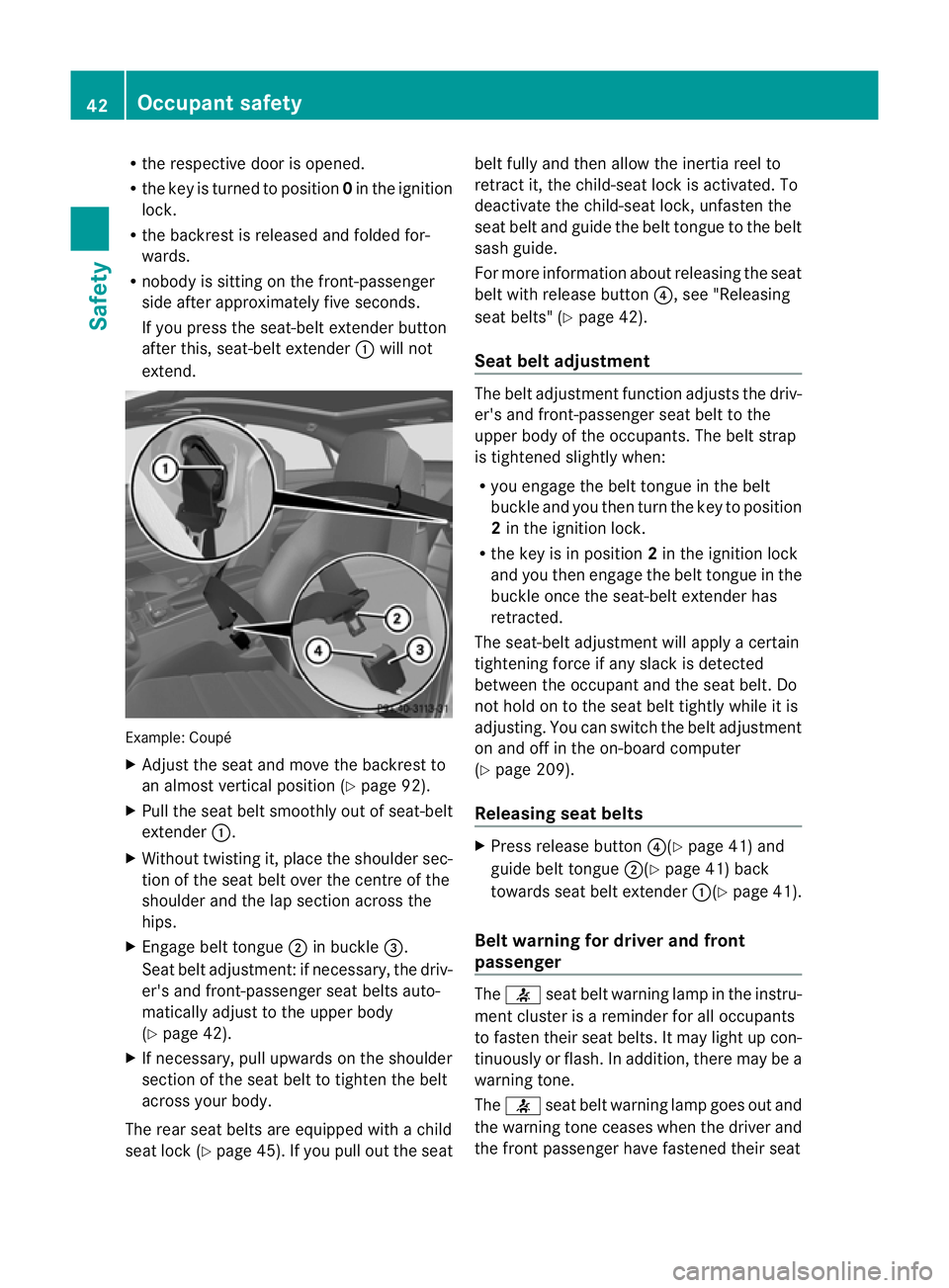
R
the respective door is opened.
R the key is turne dtoposition0in the ignition
lock.
R the backr estis release dand folde dfor-
wards.
R nobod yissitting on the front-p assenger
side after approximat elyf ives econds.
If yo upress th eseat-bel textender button
afte rthis, seat-belt extender :will not
extend. Example: Coupé
X
Adjust the seat and mov ethe backrest to
an almost vertical position (Y page 92).
X Pull the seat belt smoothly out of seat-belt
extender :.
X Withou ttwisting it, place the shoulde rsec-
tion of the seat belt over the centre of the
shoulder and the lap section across the
hips.
X Engage belt tongue ;in buckle =.
Seat belt adjustmen t:if necessary, the driv-
er' sa nd front-passenger sea tbelts auto-
maticall yadjust to the upper body
(Y page 42).
X If necessary, pull upwards on the shoulder
section of the seat belt to tighten the belt
across your body.
The rear seat belts are equipped with achild
seat lock (Y page 45). If you pull out the seat belt fully and then allow the iner
tiar eel to
ret ract it, the child-seat lock is activated. To
deactivate the child-seat lock ,unfasten the
sea tbelt and guide the belt tongue to the belt
sash guide.
For mor einformation about releasing the seat
bel tw ith release button ?,see "Releasing
seat belts" (Y page 42).
Seat belt ad justment The belt adjustment function adjusts the driv-
er' sa nd front-passenger sea tbelt to the
upper body of the occupants. The belt strap
is tightened slightly when:
R you engage the belt tongue in the belt
buckle and you then tur nthe key to position
2 in the ignition lock.
R the key is in position 2in the ignition lock
and you then engage the belt tongue in the
buckle onc ethe seat-belt extender has
ret racted.
Th es eat-belt adjust ment will appl yacertain
tightening for ceif any slack is detected
between the occupan tand the sea tbelt. Do
not hold on to the seat belt tightly while it is
adjusting. You can switc hthe belt adjustment
on and off in the on-boar dcompu ter
( Y page 20 9).
Releasin gseat belts X
Press release button ?(Ypage 41) and
guide belt tongue ;(Ypage 41) back
towards seat belt extender :(Ypage 41).
Belt warning for driver and front
passenger The
7 seat belt warnin glamp in the instru-
ment cluster is areminder for all occupants
to fasten their seat belts. It may light up con-
tinuously or flash. In addition ,ther em ay be a
warning tone.
The 7 seat belt warning lamp goes out and
the warning ton eceases when the driver and
the fron tpassenger have fastened their seat 42
Occupant safetySafety
BA 20
7ECE ÄJ 2010/1a; 1; 2, en-GB
mkalafa Version:3.0.2.11
2010-01-26T13:03:22+01:00
-Seite 42
Page 49 of 333

Child seat on th
efront-passenger seat War
ning notic eonthe front-pa ssenger sun visor War
ning symbol for arearward-facing child
restraint system G
Ris
kofi njury
If th efront-p assenger front airbag is not dis-
abled:
R ac hilds ecured in achildr estraint system
on th efront-p assenger seat could be seri-
ously and even fatally injured by the front-
passenger front airbag deploying .This is
especially arisk if the child is in the imme-
diate vicinity of the fron t-passenger front
airba gwhen it deploys.
R never secur eachild on the front-passenger
seat in arearward-facing child restraint sys-
tem. Only secur earearward-facing child
restraint system on asuitable rear seat.
R always move the front-passenger seat to
the rearmost position if you secure achild in
af orward-facing child restraint system
on the front-passenger seat.
The front-passenger front airbag is not disa-
bled:
R on vehicles withou tautomatic child seat
recognition on the front-passenger seat
R on vehicles with automatic child seat rec-
ognition on the front-passenger seat, if
there is no child restraint system with auto-
matic child seat recognition fitted to the
front-passenger seat.
R on vehicles with automatic child seat rec-
ognition on the front-passenger seat, if the
PASSENGER AIRBAG OFF warning lamp
4 is not lit.
To make you aware of this danger, acorre-
spondin gwarning sticker has been affixed on
the dashboard and on both sides of the sun
visor on the front-passenger side.
Infor mation about recommended child
restraint systems is available at any
Mercedes-Benz Service Centre.
Automatic child seat recognitio nonthe
front-passenge rseat If your vehicle does not have automatic child
seat recognition
2
on the fron t-passenger
seat, this is indicated by aspecial sticker. The
sticker is affixed to the side of the dashboard
on the front-passenger side. The sticker is
2 Vehicles withou tautomatic child seat recognition on the front-passenger seat: if you turn the key to position
2int he ignition lock ,PASSENGER AIRBAG OFF warning lamp 4lights up briefly but has no function. It
doe snot indicat ethat ther eisa utomatic child seat recognition on the front-passenger seat. 46
Children in th
evehicleSafety
BA 20 7ECE ÄJ 2010/1a; 1; 2, en-GB
mkalafa Version:3.0.2.11
2010-01-26T13:03:22+01:00
-Seite 46
Page 58 of 333

X
To activate/deactivate: press button;.
Whe nindicato rlamp :is lit, the side win-
dows in the rear can only be operated using
the switches on the driver' sdoor .When
indicator lamp :is not lit, the side win-
dows in the rea rcan also be operated using
the switches in the rear compartment. Driving safety systems
Overview of driving safety systems
In this section, you will find information about
the following driving safety systems:
R ABS ( Anti-lock BrakingSystem)
R BAS ( Brake Assist System)
R BAS PLUS ( BrakeAssist System Plus*)
R Adaptive brake lamps
R ESP ®
(Electronic StabilityProgram)
R EBD ( Electronic Brake-power Distribution)
R ADAPTIVE BRAKE
R PRE-SAFE ®
Brake (vehicles with DIS-
TRONIC PLUS) Important safety notes
G
Risk of accident
The risk of an accident is significantly
increased by driving too fast. This is particu-
larly the case when cornerin gaswell as on
wet or slippery roads or when driving too close
to the vehicle in front. The driving safet
ysystems described in this
sectio ncan neither reduce this risk nor over-
ride the laws of physics.
For this reason, always adapt your driving
style to the prevailing road and weather con-
ditions. Maintain sufficient distance from
other road users and objects on the road.
i In wintry driving conditions, always use
winter tyres (M+S tyres) and if necessary,
snow chains. Only in this way will the driv-
ing safety systems described in this section
work as effectively as possible. ABS (Anti-loc
kBrakin gSystem)
Im portan tsafety guidelines G
Ris
kofa ccident
Do not depress the brak epedal several times
in quick succession (pumping). Depress the
brak efirmly and evenly. Pumping the brake
pedal reduces the braking effect.
ABS regulates brake pressure in such away
that the wheels do not lock when you brake.
This allows you to continue steerin gthe vehi-
cle when brakin g.
AB Sw orksfrom aspeed of about 8km/h
upwards, regardless of road-surface condi-
tions. ABS works on slippery surfaces, even
when yo uonly brake gently.
Braking If ABS intervenes whe
nbraking, yo uwill feel
ap ulsing in the brake pedal.
X If ABS intervenes: continue to depressthe
brake pedal with for ceuntil the braking sit-
uation is over.
X To mak eafull brake application:
depress th ebrake peda lwith full force. G
Risk of accident
If ABS is faulty, the wheels could lock when
braking. This limits the steerability of the vehi- Driving safet
ysystems
55Safety
BA 207 ECE ÄJ 2010/1a; 1; 2, en-GB
mkalafa Version: 3.0.2.11 2010-01-26T13:03:22+01:00 -Seite 55 Z
Page 59 of 333
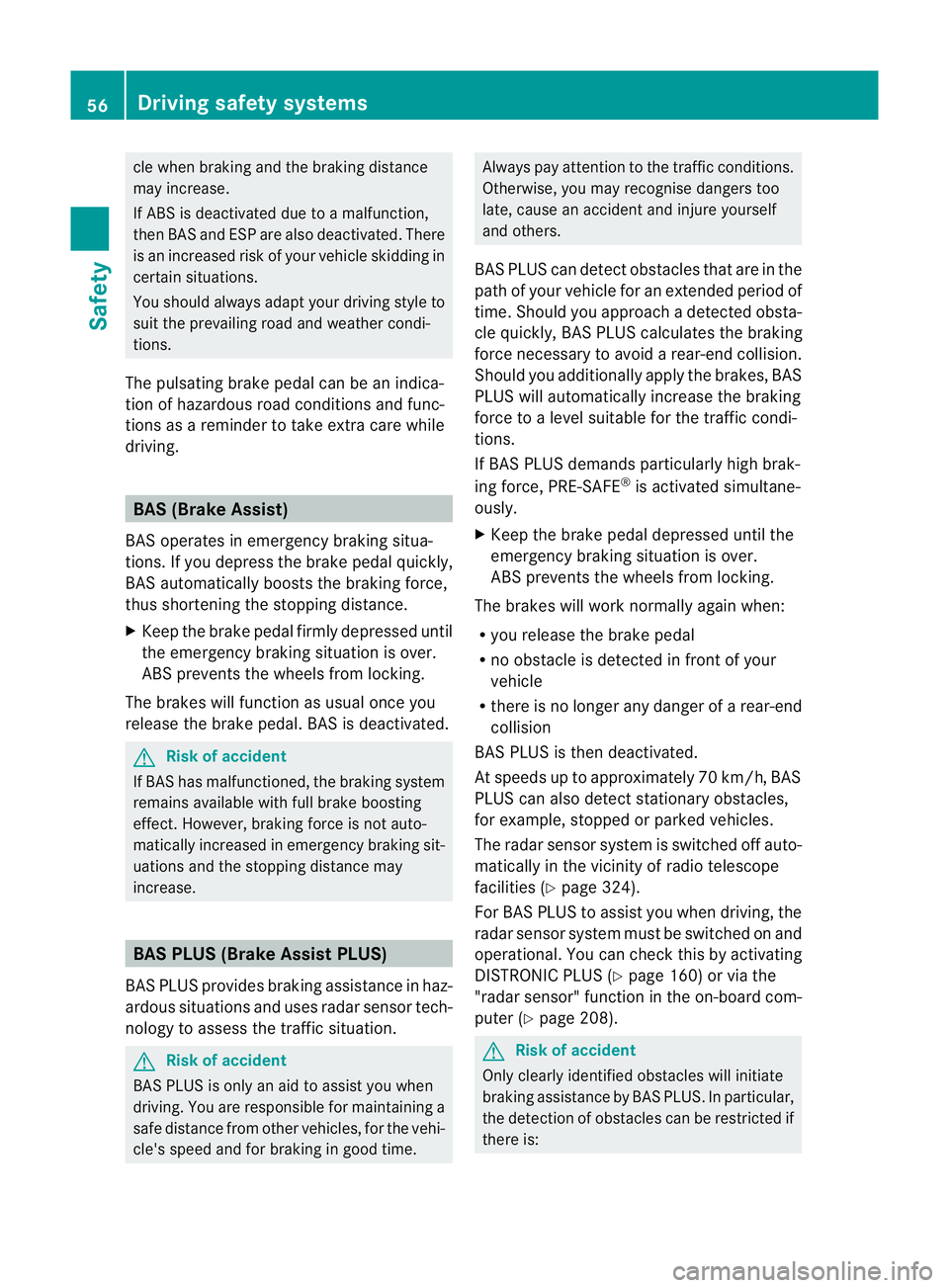
cle whe
nbraking and th ebraking dist ance
may increas e.
If ABS is de activated due to amalfunction,
then BAS and ESP are als odeactivated. There
is an increase drisk of you rvehicle skidding in
cer tain situations.
You should always adapt your drivin gstyle to
suit the prevailing road and weather condi-
tions.
The pulsating brake pedal can be an indica-
tion of hazardous road conditions and func-
tions as areminder to take extra car ewhile
driving. BAS (Br
akeA ssist)
BA So perates in emergency braking situa-
tions. If you depress the brak epedal quickly,
BAS automatically boosts the braking for ce,
thus shortening the stopping distance.
X Keep the brake peda lfirmly depressed until
the emergency brakin gsituation is over.
ABS prevents the wheels from locking.
The brakes will function as usual onc eyou
release the brake pedal. BA Sisd eactiva ted. G
Risk of accident
If BAS has malfunctioned, the braking system
remains available with ful lbrake boosting
effect. However, braking force is not auto-
matically increased in emergency braking sit-
uations and th estoppi ngdistanc emay
increase. BAS PLUS (Brake Assis
tPLUS)
BAS PLU Sprovide sbraking assistance in haz-
ardou ssituation sand use sradar senso rtech-
nology to assess the traffic situation. G
Risk of accident
BAS PLU Siso nly an aid to assist you when
driving. You are responsible for maintaining a
safe distanc efrom other vehicles ,for the vehi-
cle' sspeed and for braking in good time. Alway
spay attention to the traffic conditions.
Otherwise, you may recognise dangers too
late, cause an acciden tand injure yourself
and others.
BAS PLUS can detect obstacle sthat ar einthe
pat hofyour vehicle for an extended period of
time. Should you appr oachad etected obsta-
cle quickly, BA SPLUSc alculates the braking
force necessary to avoid arear-end collision.
Should you additionally apply th ebrakes, BAS
PLUS wil lautomatically increase the braking
force to alevel suitabl efor the traffic condi-
tions.
If BA SPLUS demands particularl yhigh brak-
ing force, PRE-SAFE ®
is activated simultane-
ously.
X Keep the brak epedal depressed until the
emergency braking situation is over.
AB Sp revents th ewheels fr om lockin g.
The bra kesw ill work normally again when:
R you release the brak epedal
R no obstacle is detected in fr ontof your
vehicle
R there is no longer any danger of arear-end
collision
BA SP LUS is then deactivated.
At speeds up to appro ximately 70 km/h ,BAS
PLU Scan also detect stationary obstacles,
for example, stopped or parked vehicles.
The radar sensor system is switched off auto-
matically in the vicinit yofradio telescope
facilities (Y page 324).
For BA SPLUS to assist yo uwhen driving, the
radar sensor system must be switched on and
operational. You can chec kthis by activating
DI ST RONIC PLUS (Y page 160) or via the
"rada rsensor "function in the on-board com-
puter (Y page 208). G
Risk of accident
Only clearly identified obstacles will initiate
brakin gassistanc ebyBAS PLUS. In particular,
the dete ction of obstacles can be restricted if
there is: 56
Drivin
gsafety systemsSafety
BA 207 ECE ÄJ 2010/1a; 1; 2, en-GB
mkalafa Version: 3.0.2.11
2010
-01-26T13:03:22+01:00 -Seite 56